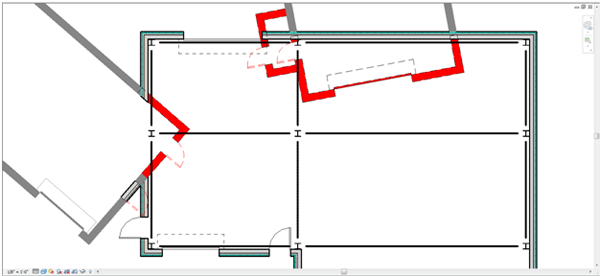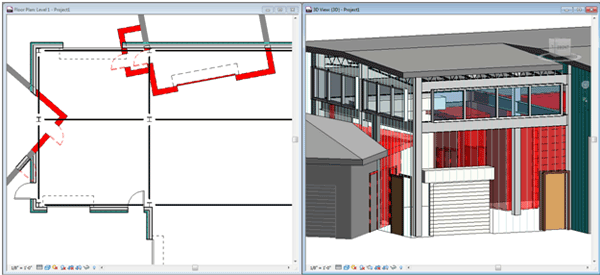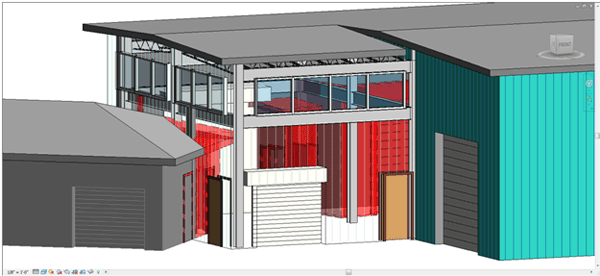
Numerous government agencies are moving ahead by incorporating the
Building Information Modeling (BIM) process into their workflow, but some are still yet to be convinced of the benefits that an intelligent model can provide. Recently, we assisted a public sector client faced with a unique challenge; they had to decide whether to retrofit two existing structures into one or demolish both and build a new structure. Using the BIM process, we were able to help them identify substantial cost and time savings by changing the direction of the project from demolition and rebuild, to a retrofit.
This particular government agency was investigating the feasibility of retrofitting two side-by-side existing structures in order to combine them into one larger building. However, due to the large footprint of the existing buildings, the engineers were sceptical and thought they would need to demolish both and start from scratch – an expensive proposition. From an examination of the 2D drawings, the neighboring structures had been constructed independently without any uniformity and very little similarity in design. Each had contrasting angles to the other and it didn’t appear possible to incorporate the two into one. It was decided to use the BIM process to obtain an accurate account of the materials used in the existing properties and to see how the two might be combined. This procedure would help to determine what existing materials could be reused and what new materials would be required. It would also assist in determining the consequences a demolition would have on the property’s adjacent surroundings, the grounds and underground infrastructure.
Building the Model
The first step involved importing the existing original 2D drawings of the two buildings into Autodesk Revit and then generating a 3D image to accurately recreate the current conditions. Using Revit, the team visualized the existing structures and a timeline was created for the various demolition/retrofit scenarios
Models using three different products (Revit Architecture, AutoCAD MEP and Revit Structural) were integrated to conduct inference tests on each of the retrofit and rebuild scenarios. By generating these details in the model stage, issues could be dealt with quickly and easily and the new construction design was confirmed to work.
This comprehensive evaluation clearly demonstrated that the new structure could be built using the existing structures and changed the focus from a demolition and new construction to a more economical renovation. A plan was developed which left a substantial part of the existing structures intact and would allow for small areas to be carefully demolished. From these two existing structures, the new building would emerge. Overall, we estimated they could reuse at least 50 per cent of the existing structures which led to an enormous cost savings by eliminating a major demolition and requiring fewer new materials and a shorter construction timeline. The environmental impact was also drastically reduced because of the reuse of materials and the reduced impact on the surrounding environment.
Before the use of BIM and intelligent models allowing teams to collaborate on accurately designing, visualizing and simulating structures, this type of in depth evaluation would have taken up to five times longer. Furthermore, because of the client’s initial scepticism that a renovation would actually work, this upfront work may not even have been undertaken. Now that the BIM process can quickly take the guesswork out of the equation, more options to create better construction solutions are being explored. In fact, the effectiveness of this evaluation has led this government agency to institute a policy that a 3D BIM model is required for all future projects. It’s now an essential step in their project workflow.
By Bryan Cowles, Applications Specialist & BSD Technical Team Manager, IMAGINiT Technologies
About Bryan Cowles
Bryan Cowles is a recognized industry speaker on building information modeling and has helped guide numerous government and private sector clients through challenging visualization projects. You can reach him at 800-733-8941 or
bcowles@rand.com.
More Information
Read more articles about BIM in the public sector by selecting “BIM” or “Building Information Modeling” from our topic tag cloud. You can also read more about Autodesk solutions for BIM at
www.dlt.com/BIM.



The images of these sample models demonstrate the integrated timeline model: the grey parts are the existing structures before the retrofit and the red parts represent the proposed parts to be demolished. The rest of the geometry is the new construction to be retrofit around the two existing buildings.
 Numerous government agencies are moving ahead by incorporating the Building Information Modeling (BIM) process into their workflow, but some are still yet to be convinced of the benefits that an intelligent model can provide. Recently, we assisted a public sector client faced with a unique challenge; they had to decide whether to retrofit two existing structures into one or demolish both and build a new structure. Using the BIM process, we were able to help them identify substantial cost and time savings by changing the direction of the project from demolition and rebuild, to a retrofit.
This particular government agency was investigating the feasibility of retrofitting two side-by-side existing structures in order to combine them into one larger building. However, due to the large footprint of the existing buildings, the engineers were sceptical and thought they would need to demolish both and start from scratch – an expensive proposition. From an examination of the 2D drawings, the neighboring structures had been constructed independently without any uniformity and very little similarity in design. Each had contrasting angles to the other and it didn’t appear possible to incorporate the two into one. It was decided to use the BIM process to obtain an accurate account of the materials used in the existing properties and to see how the two might be combined. This procedure would help to determine what existing materials could be reused and what new materials would be required. It would also assist in determining the consequences a demolition would have on the property’s adjacent surroundings, the grounds and underground infrastructure.
Building the Model
The first step involved importing the existing original 2D drawings of the two buildings into Autodesk Revit and then generating a 3D image to accurately recreate the current conditions. Using Revit, the team visualized the existing structures and a timeline was created for the various demolition/retrofit scenarios
Models using three different products (Revit Architecture, AutoCAD MEP and Revit Structural) were integrated to conduct inference tests on each of the retrofit and rebuild scenarios. By generating these details in the model stage, issues could be dealt with quickly and easily and the new construction design was confirmed to work.
This comprehensive evaluation clearly demonstrated that the new structure could be built using the existing structures and changed the focus from a demolition and new construction to a more economical renovation. A plan was developed which left a substantial part of the existing structures intact and would allow for small areas to be carefully demolished. From these two existing structures, the new building would emerge. Overall, we estimated they could reuse at least 50 per cent of the existing structures which led to an enormous cost savings by eliminating a major demolition and requiring fewer new materials and a shorter construction timeline. The environmental impact was also drastically reduced because of the reuse of materials and the reduced impact on the surrounding environment.
Before the use of BIM and intelligent models allowing teams to collaborate on accurately designing, visualizing and simulating structures, this type of in depth evaluation would have taken up to five times longer. Furthermore, because of the client’s initial scepticism that a renovation would actually work, this upfront work may not even have been undertaken. Now that the BIM process can quickly take the guesswork out of the equation, more options to create better construction solutions are being explored. In fact, the effectiveness of this evaluation has led this government agency to institute a policy that a 3D BIM model is required for all future projects. It’s now an essential step in their project workflow.
By Bryan Cowles, Applications Specialist & BSD Technical Team Manager, IMAGINiT Technologies
About Bryan Cowles
Bryan Cowles is a recognized industry speaker on building information modeling and has helped guide numerous government and private sector clients through challenging visualization projects. You can reach him at 800-733-8941 or bcowles@rand.com.
More Information
Read more articles about BIM in the public sector by selecting “BIM” or “Building Information Modeling” from our topic tag cloud. You can also read more about Autodesk solutions for BIM at www.dlt.com/BIM.
Numerous government agencies are moving ahead by incorporating the Building Information Modeling (BIM) process into their workflow, but some are still yet to be convinced of the benefits that an intelligent model can provide. Recently, we assisted a public sector client faced with a unique challenge; they had to decide whether to retrofit two existing structures into one or demolish both and build a new structure. Using the BIM process, we were able to help them identify substantial cost and time savings by changing the direction of the project from demolition and rebuild, to a retrofit.
This particular government agency was investigating the feasibility of retrofitting two side-by-side existing structures in order to combine them into one larger building. However, due to the large footprint of the existing buildings, the engineers were sceptical and thought they would need to demolish both and start from scratch – an expensive proposition. From an examination of the 2D drawings, the neighboring structures had been constructed independently without any uniformity and very little similarity in design. Each had contrasting angles to the other and it didn’t appear possible to incorporate the two into one. It was decided to use the BIM process to obtain an accurate account of the materials used in the existing properties and to see how the two might be combined. This procedure would help to determine what existing materials could be reused and what new materials would be required. It would also assist in determining the consequences a demolition would have on the property’s adjacent surroundings, the grounds and underground infrastructure.
Building the Model
The first step involved importing the existing original 2D drawings of the two buildings into Autodesk Revit and then generating a 3D image to accurately recreate the current conditions. Using Revit, the team visualized the existing structures and a timeline was created for the various demolition/retrofit scenarios
Models using three different products (Revit Architecture, AutoCAD MEP and Revit Structural) were integrated to conduct inference tests on each of the retrofit and rebuild scenarios. By generating these details in the model stage, issues could be dealt with quickly and easily and the new construction design was confirmed to work.
This comprehensive evaluation clearly demonstrated that the new structure could be built using the existing structures and changed the focus from a demolition and new construction to a more economical renovation. A plan was developed which left a substantial part of the existing structures intact and would allow for small areas to be carefully demolished. From these two existing structures, the new building would emerge. Overall, we estimated they could reuse at least 50 per cent of the existing structures which led to an enormous cost savings by eliminating a major demolition and requiring fewer new materials and a shorter construction timeline. The environmental impact was also drastically reduced because of the reuse of materials and the reduced impact on the surrounding environment.
Before the use of BIM and intelligent models allowing teams to collaborate on accurately designing, visualizing and simulating structures, this type of in depth evaluation would have taken up to five times longer. Furthermore, because of the client’s initial scepticism that a renovation would actually work, this upfront work may not even have been undertaken. Now that the BIM process can quickly take the guesswork out of the equation, more options to create better construction solutions are being explored. In fact, the effectiveness of this evaluation has led this government agency to institute a policy that a 3D BIM model is required for all future projects. It’s now an essential step in their project workflow.
By Bryan Cowles, Applications Specialist & BSD Technical Team Manager, IMAGINiT Technologies
About Bryan Cowles
Bryan Cowles is a recognized industry speaker on building information modeling and has helped guide numerous government and private sector clients through challenging visualization projects. You can reach him at 800-733-8941 or bcowles@rand.com.
More Information
Read more articles about BIM in the public sector by selecting “BIM” or “Building Information Modeling” from our topic tag cloud. You can also read more about Autodesk solutions for BIM at www.dlt.com/BIM.

 The images of these sample models demonstrate the integrated timeline model: the grey parts are the existing structures before the retrofit and the red parts represent the proposed parts to be demolished. The rest of the geometry is the new construction to be retrofit around the two existing buildings.
The images of these sample models demonstrate the integrated timeline model: the grey parts are the existing structures before the retrofit and the red parts represent the proposed parts to be demolished. The rest of the geometry is the new construction to be retrofit around the two existing buildings.
















































